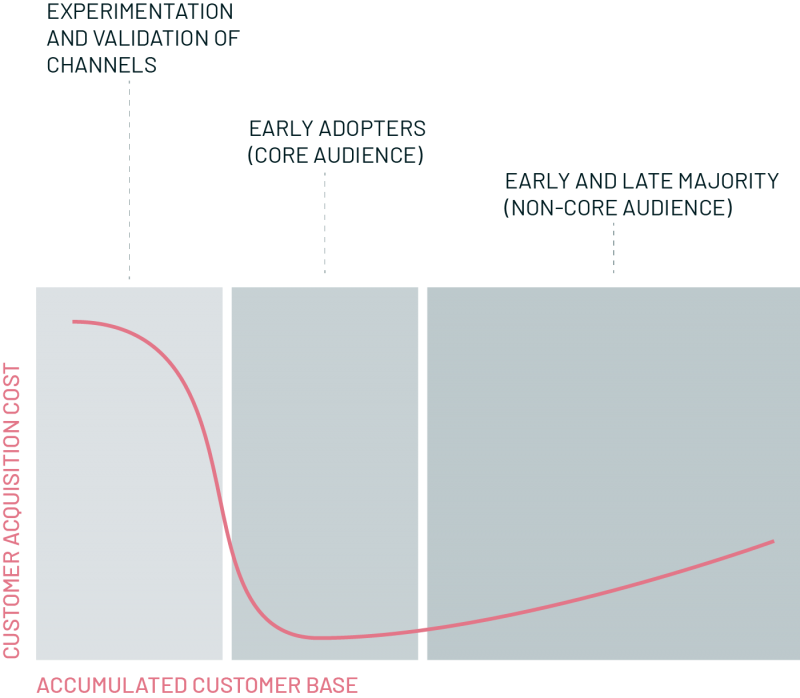Launching new offerings successfully in B2B markets is hard. Mostly driven by innovation or technological advancements, newly developed propositions need to attract a sufficient amount of tech enthusiasts or early adopters in order to achieve initial market traction. But in order to sustain long-term growth, one needs to manage to convince early majority market segments. In this market-entry process marketing units often rely too heavily on either old distribution channels or on paid marketing strategies. However, in order to succeed, companies need to take a more holistic view of growth.
Why many growth tactics of new ventures fail
Imagine this familiar story: A new venture/product/offering is launched to market. First leads bring a nice growth curve, but it soon dives down again. Time to spend some marketing dollars to sustain growth. With increasing marketing spending, growth comes back, and each new user cohort is growing nicely. It’s working! More money is spent, everyone moves into a bigger office. All of a sudden, user acquisition begins to stall, CAC (customer acquisition cost) payback period stretches now well beyond 12 months. Unit economics become less and less profitable. Without hockey stick growth charts, it’s hard to persuade stakeholders and investors to raise more money. Hence, employees are laid off, costs are cut. Something needs to happen to bring kickstart growth again. Pivot, new monetisation models, new paid marketing tactics? Nothing works really, hence the whole thing is shut down or dies in irrelevance.
Never ever rely on a narrow set of (paid) distribution channels
The problem with a narrow view on relying on the typical marketing channels is that they’re very hard to scale, as they’re directly dependent on your competition’s marketing activities and the platform itself. Hence, it is of crucial importance to analyse all marketing channels separately at the beginning to understand which work best, which have the best conversion and CAC and where the organic growth mostly comes from.
Paid marketing tactics work well to get initial market traction. However, the growth plan of a new venture needs to be built on other factors, as the economics of paid marketing doesn’t scale. Your audience will be saturated at some point. Your competition will be quick to copy your killer features and best-performing campaigns.
Paid marketing performance will inevitably follow a regression to the mean. Your best customers are your early adopters. To find them in the first place, you need a thorough market segmentation and a targeted value proposition. These customers will provide early growth, but the segment sizes are usually not big enough. After saturating your core demographics, you need to spend enormously more money to reach the early and late majorities, especially since they’re much harder to win over. They have their own segment-specific needs and usually are less interested in the underlying tech, but in initial sales volumes, trade press coverage, standards certifications or third-party support.

Approaches to sustain long-term growth
As solely relying on paid marketing tactics is not a good idea, growth teams need to take a holistic view and build bridges across product, marketing, ops and everyone else involved. Most moats are built on finding unique growth channels that are supported by highly context-specific product features, such as the folder sharing feature at Dropbox.
Market segmentation
The most sustainable way to grow is through word-of-mouth (WOM). As stated earlier, this requires a valid customer segmentation strategy, which outlines need-based customer groups that actively share industry-specific news. If there’s no in-segment communication, there won’t be any WOM. After you know which initial segment you’re going after, you need to get customer insights to base your product roadmap and USPs on.
- Which users have a problem that you can solve faster, better or cheaper than anyone else on the market?
- Which segment is the most viable one?
- Can you build a proposition that not only excites tech enthusiasts but also early adopters?
Embrace the basics of marketing
After knowing which segments are the most promising to your venture, it’s important to orchestrate all marketing relevant growth drivers. That means going beyond performance marketing, which should come last.
The most important starting point will always be your product and engineering. Invest in making your product better, i.e. solving your customers’ pain points, and you’ll grow. In contrast, you can’t spend your way to growth by advertising a bad product, at least not in the long run. Revolut is an example of a high-growth Fintech startup that shipped new value-adding features almost on a monthly basis, which eliminated the need to spend unjustifiably in paid marketing.
Price is the marketing component that only a few really get right. Many times, companies spend too little time testing out different pricing (how much you charge) and monetisation models (how you charge). Again, knowing your customer’s buying journey well allows you to innovate your pricing model, such as subscriptions, dynamic pricing, auctions or pay-as-you-go. For instance, a few years ago, Michelin understood that one of their customer segments, truckers, were forced to operate on extremely small margins due to various market developments. Michelin thereafter moved from selling products to services that provided real value to truckers, called Effifuel, and monetised based on product usage and resulting benefits instead of the tire sales.
The most important starting point will always be your product and engineering.
The right place to sell your offering again should be built first from a pure customer perspective: What’s the most effective and convenient channel to purchase your product? Whether you need to build your own app or sell on existing marketplaces will depend on the gathered user insights. In the best case, you can try out a variety of channels and then nail down two or three.
Finally, promoting your solution is what most growth teams think about. Nevertheless, it’s only one variable of growth and should ideally build on the previously mentioned components. Let the marketers responsible for getting leads in participate in early segment and customer discoveries and subsequent product development, as they need to get the user’s needs in order to come up with resonating USPs and messaging.
After all, sustainable growth is about not only acquisition but also engagement, retention, and re-activation. In order to ensure a long-term growth system for new ventures and products, the whole team needs to collaborate to build a great product that’s independent of paid channels.
Sources
CNBC Markets, Monday 7 May 2018: “Warren Buffett believes this is ‘the most important thing’ to find in a business”
https://www.cnbc.com/2018/05/07/warren-buffett-believes-this-is-the-most-important-thing-to-find-in-a-business.html

About the author


